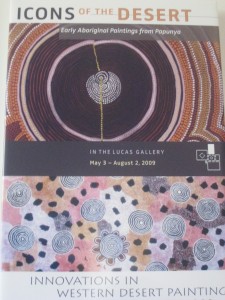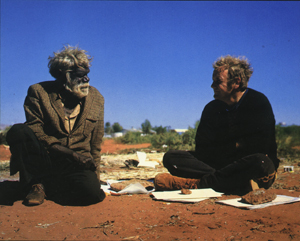
"Icons of the Desert" exhibit
The doors opened slowly, and we entered the “Icons of the Desert” exhibit. On the walls around us hung Australian Aboriginal paintings from a tiny settlement called Papunya. I felt as if I had just gone back in time to the 1970s when the Sydney school teacher Geoffrey Bardon gave the Aboriginal men paint and cardboard to transfer their designs and dreamings to a more permanent surface than their skin or the ground.
Our tour guide at the museum began by discussing a couple of the paintings with us. When I first looked at them, I saw what I thought of as typical Aboriginal paintings that contained earth-tone colors and ceremonial figures. However, as she pointed out different symbols in one of the pictures and the meaning behind them, we started to uncover information about the Australian Aboriginal culture. The painting was no longer just a painting that I looked at and moved on to another one; it became a story that grabbed my attention. In fact, many of the paintings were maps of the land. For example, the circles represented waterholes, and U shapes represented men. I was fascinated that the Papunya artists could make a map look like such a beautiful painting. Today our maps look nothing like a work of art. I wish I could have seen the Aboriginals paint the actual pictures.

Papunya Artist-1971
When the Papunyas first started transferring their designs to the cardboard, their paintings depicted realistic events and contained sacred imagery that were never meant to be seen by women or children. When the men realized they were revealing too much, they began using dots and lines to make the paintings more abstract and to form a veil of secrecy over the underlying messages in the painting. Some of the pictures were now considered appropriate for women and children to see. The tour guide told us we were not allowed to take pictures of the images, for they were sacred. I asked myself, “Then why are we allowed to see them?” Our tour guide said it is because we are Americans and would not get it. I wish other cultures did not look down on Americans so much.

An Australian Aboriginal man and Geoffrey Bardon
In history class, we have learned about how the Native Americans were treated horribly and placed in reservations. Children were taken away from parents and forced to assimilate to the American culture in schools. This same type of treatment happened with the Aboriginal people of Australia, and my knowledge of Native Americans helped me to better understand the lives of the people that painted the pictures we were seeing. Before going to the Fowler Museum to see this exhibit, I had no idea what to expect. I did not know what we were going to be seeing or whether I would be interested. I left the museum today with an appreciation for early Aboriginal paintings and a desire to learn more about the Papunya culture.
http://www.iconsofthedesert.com/
http://www.aboriginal-art.com/desert_pages/papunya_intro.html